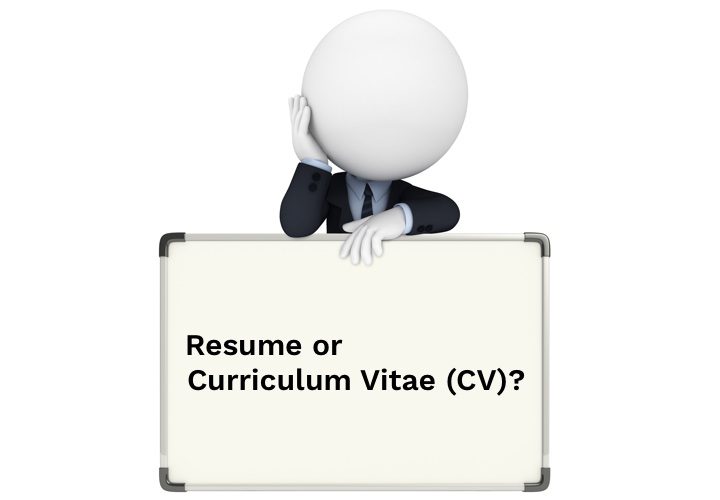
Whether you’re applying for a scholarship, a place on a master’s course or a full-fledged job, you need to provide relevant information to sell yourself to those choosing the best candidate.
The best way to do so is to create a killer resume or curriculum vitae (CV) that describes you, your experience and all you’ve achieved thus far.
How do you know which type of document to produce, though?
To some, a resume and a CV may seem like interchangeable words. It turns out there are differences between the two documents, as well as differences in the types of places you’d send a resume versus a CV.
To make that decision clearer — and to make the creation of your resume or CV easier for you — here are the biggest differences between the two documents.
The Resume
A resume is the typical document required of job applicants in the United States and Canada. We’ll talk about other countries a bit further down in this article.
The resume is a summary of your work and educational experience. You’ll have to be strategic in creating your resume so it highlights all your best work, since the document is a summary — you can’t describe every single accomplishment you’ve had throughout your career. Don’t be afraid to cut and tailor your resume to every job you apply for, either.
Unless otherwise specified, you should assume that most hiring managers expect a resume. The world of academia is a different story — they might just expect a lengthier, in-depth CV instead — but more on that later.
What Does It Look Like?
Often, recruiters and HR managers receive several applications for one available job opening. They want to browse through resumes quickly to narrow down the pool to interview candidates. That’s why your resume shouldn’t be more than about two pages and comprise easy-to-scan bullet points that spotlight your greatest achievements.
In the few minutes someone spends glancing at your resume, you have to make sure they realize you stand apart from the crowd.
Your resume should always include work experience, especially experience most relevant to the position to which you’re applying. Ideally, your resume should be tailored to the field in which you want to work and the job you want to obtain. So, even if you were editor of your university’s newspaper, it may not be relevant when applying to teach science at the local high school.
You should always strive to add a summary at the top of your resume. It should be short, sweet and to the point. If anything, you can flesh out your expectations and highlight your greatest achievements in your cover letter — many employers require applicants to send both.
The Curriculum Vitae
Curriculum vitae means course of life in Latin, which is your first clue that a CV is quite a bit longer than a resume. This document is the most popular in the academic world, where aspiring researchers, master’s students and Ph.D. candidates can flesh out all their accomplishments.
More importantly — especially in the case of academics — the CV is a place for you to share all your educational accomplishments and publications. The latter is especially important for those aiming to rise in the ranks of higher education.
Publication gives your research and standing more clout. In short, an educational institution will love to take you on if you’ve proven your ability to get published, so you can get their name out there, too.
CVs made in pursuit of higher education should also include your teaching experience, previous degrees, any presentations you’ve given on your study area and, of course, the awards you’ve already received.
You’ll have plenty of space to flesh out all this information, and because the document is so long, you can likely create one CV that will apply to every application you submit — unlike the short-and-sweet resume.
Of course, the CV isn’t just used for students aspiring for higher-level degrees. CVs are the common job application document in many countries. They’re also used for those entering the field of medicine.
What Does It Look Like?
Anyone who has pursued a degree beyond a bachelor’s knows how much it takes and how much there is to talk about. That’s why CVs are typically longer than the quick, bullet-pointed resume. Even an entry-level CV can span two pages, and some more in-depth ones are pages long.
Like a resume, your CV should be blocked into categories. A good way to build your CV is to first brainstorm all of the accomplishments you want to include. Then, once you have them all written down, group them into categories.
You’ll want to make sure your CV includes all of your top academic accomplishments, such as:
- Research completed
- Teaching experience
- Professional association memberships and licenses
- Grants
- Fellowships and scholarships
- Awards
- Publications
- Presentations
Again, all of this will have to be ordered on your CV page to flow logically from one category to the next.
Don’t Forget the International Expectations
Not all job or educational applications come with a request specifically for a resume or a CV. If you’re applying abroad, it’s good to know where the former is expected, where the latter is expected and where the terms are more or less interchangeable.
If you want a job in the United States or Canada, chances are they’ll ask for a resume. The only time you would be expected to produce a lengthier CV would be if you’re applying for a research position or otherwise academic pursuit.
In the United Kingdom, Ireland, New Zealand and most of Europe, the CV reigns supreme. This is true of any position, academic or professional — those selecting candidates will want a fully detailed CV.
Then, of course, there are the wildcards. Places like Australia, South Africa and India use the terms resume and CV interchangeably, but there is one differentiation: The CV is often used for positions in the public sector, while the resume suffices for most private-sector jobs.
Is There Any Overlap?
These are the typical scenarios that would call for a resume or a CV. Of course, it’s not always black-and-white, and you might find yourself submitting a CV with your next job application or a resume for that post-grad scholarship you really want.
The most important thing to remember while writing your resume or CV is that you’re including the information your employer or educational institution wants to hear. You should always make sure your writing is clear, and the structure is logical. The look of the document should always be clean, too.
If you want to be extra cautious, prepare both a resume or CV prior to your job or fellowship search. It might take a bit more time to prepare both documents, but you’ll be happy to have them on hand when you apply and find one institution wants a resume, while the next wants the CV.
As always, don’t be shy about sharing your achievements, whether they’re professional or academic. You’ve worked hard to build that impressive CV or resume, so show it off — the right people will be sure to notice.
p.s. Resumonk’s AI Resume Builder helps you create an impressive résumé/CV in minutes with its AI-driven rewrites and suggestions, alongside convenient import from LinkedIn or PDF/DOCX features. Start your free trial today!
Check out these reviews on how it has helped thousands of people achieve their professional goals.



